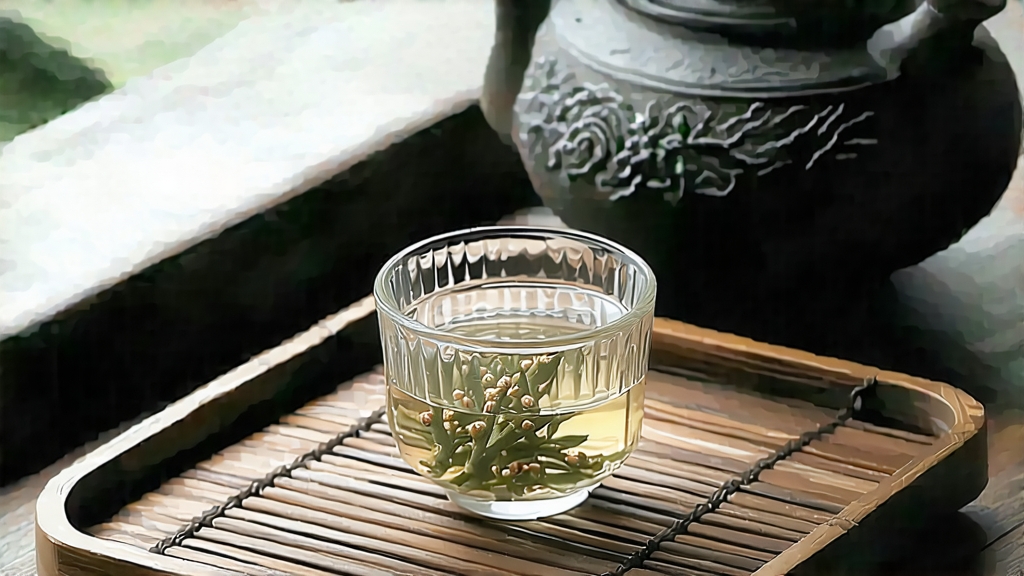
If green tea is spring’s first cry and pu-erh an autumn philosopher, then Fuding White Needle—Bai Hao Yin Zhen in Chinese—is moonlight caught in leaf form: pale, silent, yet astonishingly luminous. Among all white teas it is the rarest, the least handled, and the most likely to convert a casual drinker into a lifelong pilgrim. Its story begins in the coastal hills of Fuding, northern Fujian, where the East China Sea’s fog meets subtropical bamboo forests, creating a micro-climate that tea growers call “the silver screen”: cool nights that slow oxidation, warm days that coax amino acids, and a dew that tastes faintly of salt.
Historical records first mention “silver buds” during the Song dynasty (960-1279), when imperial tribute lists requested “small buds, downy white, to be picked before the insects wake.” Yet the modern name Bai Hao Yin Zhen did not appear until the late Qing, when European buyers in Fuzhou port discovered that these unopened shoots, air-dried rather than pan-fired, retained their perfume after months at sea. By 1891 Fuding White Needle had become the most expensive Chinese leaf on the London market, outselling even Da Hong Pao ounce for ounce. The 1915 Panama-Pacific International Exhibition awarded it a gold medal, sealing its global reputation before two world wars and China’s civil turmoil almost erased it from memory. Only in the 1960s did state tea institutes re-graft ancient cultivars, and today fewer than three thousand acres of true-origin bushes remain, all within a thirty-kilometer radius of Taimu Mountain.
Botanically, the tea belongs to the Fuding Da Bai cultivar, a large-leaf variety whose spring buds can reach 3.5 cm, each sheathed in a down so dense it resembles hoarfrost. Picking occurs during a five-day window around Qingming festival; workers pluck only the unopened shoot, rejecting any leaf that has unfurled even a millimeter. A skilled picker gathers barely 500 grams of fresh buds per day, the first step in a craft chain that will lose seventy percent of its weight before the final tea is born.
Processing is disarmingly simple yet maddeningly precise. The buds are spread on bamboo trays exactly 2 cm thick, then left to wither for thirty-six to forty-eight hours while artisans “borrow heaven’s hand.” No shaking, no rolling, no firing—only the rhythm of moisture leaving the cells and ambient enzymes nibbling at polyphenols. The critical variable is air: it must smell of pine and sea, move at less than 0.5 m per second, and carry 65 % relative humidity. If the night turns arid, workers cover the trays with wet hemp; if rain threatens, they slide everything into a pine-wood corridor whose rafters exhale decades of tea perfume. When the bud’s moisture drops to 10 %, a final thirty-minute “sunbath” at dawn fixes the silvery appearance and locks in a fragrance that chemists describe as a marriage of lilac monoterpenes and seaweed bromophenols. No machine can replicate this; even a stainless-steel table will bruise the down and oxidize the tip into an unseemly rust.
The dry tea looks like a cache of miniature spears: straight, uniform, the color of antique ivory touched with jade. Aroma from the bag is subtle—milkweed, wet stone, a suggestion of almond—but place five grams in a pre-warmed glass and the buds awaken, releasing a plume that carries the same ionic snap one smells before a thunderstorm. Western cupping protocols often miss this, because White Needle is shy below 80 °C; above that, volatile esters volatilize too fast, leaving only cooked-grass notes.
To brew it Western-style, use 3 grams per 250 ml of water at 75 °C and steep four minutes. The liquor is the palest champagne, almost transparent, yet it coats the tongue like silk. First infusions deliver honeydew, white peach, and a cooling finish reminiscent of wintergreen. A second steep, lengthened to five minutes, adds marine minerality and a faint creaminess that Chinese texts call “tofu water.” A third infusion, six minutes, surprises with